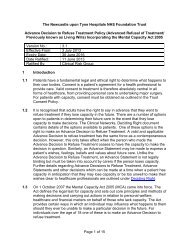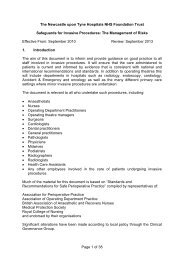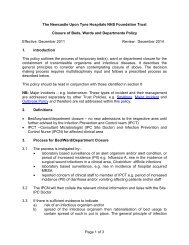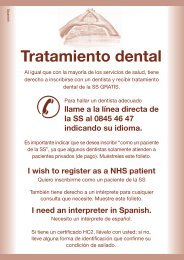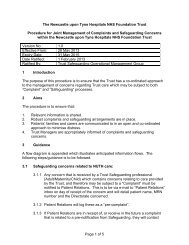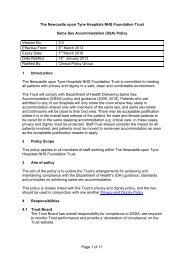Policy for the prevention and management of Needlestick Injuries ...
Policy for the prevention and management of Needlestick Injuries ...
Policy for the prevention and management of Needlestick Injuries ...
You also want an ePaper? Increase the reach of your titles
YUMPU automatically turns print PDFs into web optimized ePapers that Google loves.
The Newcastle upon Tyne Hospitals NHS Foundation Trust<br />
<strong>Policy</strong> <strong>for</strong> <strong>the</strong> Prevention <strong>and</strong> Management <strong>of</strong> <strong>Needlestick</strong> <strong>Injuries</strong><br />
<strong>and</strong> Blood Borne Virus Exposures<br />
Version No : 6.2<br />
Effective from 17 th July 2013<br />
Expiry Date: 31 st March 2015<br />
Date Ratified: 17 th July 2013<br />
Ratified by: H&S Committee<br />
1 Introduction<br />
All healthcare workers potentially are at risk from exposure to blood <strong>and</strong>/or body<br />
fluids. Whilst it is accepted that not all blood or body fluids are potentially infective, it<br />
is recommended that Safer Sharps Device/Needle Free Device <strong>and</strong> Universal<br />
Precautions be adopted whenever <strong>the</strong>re is <strong>the</strong> potential <strong>for</strong> exposure to reduce <strong>the</strong><br />
risk <strong>of</strong> transmission <strong>of</strong> blood-borne viruses.<br />
Exposure to blood or o<strong>the</strong>r potentially infectious body fluids may result in <strong>the</strong><br />
transmission <strong>of</strong> blood-borne viruses (BBVs) including HIV, hepatitis B virus (HBV)<br />
<strong>and</strong> hepatitis C virus (HCV). Advice about o<strong>the</strong>r possible occupational risks <strong>for</strong><br />
health care staff following such exposures, such as less common BBV’s or<br />
transmissible spongi<strong>for</strong>m encephalopathies (e.g. CJD), should be obtained from <strong>the</strong><br />
Occupational Health Department, a medical microbiologist, a medical virologist or<br />
<strong>the</strong> doctor on call <strong>for</strong> Infectious Diseases.<br />
2 <strong>Policy</strong> Scope<br />
This policy applies to all staff employed or undertaking work <strong>for</strong> or on behalf <strong>of</strong><br />
Newcastle Upon Tyne Hospitals NHS Foundation Trust in both hospital or<br />
community based settings. Whilst it is primarily concerned with occupational risks <strong>for</strong><br />
health care staff <strong>and</strong> students, but may also be applied to patients attending <strong>the</strong> A &<br />
E department after needlestick or o<strong>the</strong>r exposures in <strong>the</strong> community, when HBV<br />
infection is generally likely to be <strong>the</strong> most important risk. This policy must also be<br />
applied to patients or visitors at risk who have received a needlestick injury or blood<br />
borne virus exposure.<br />
3 Aim <strong>of</strong> <strong>Policy</strong><br />
This policy is intended to ensure that where ever possible <strong>prevention</strong> <strong>of</strong> sharps<br />
injuries is paramount <strong>and</strong> reduced to a minimum. Use <strong>of</strong> all sharps/needles are risk<br />
assessed <strong>and</strong> where reasonably practicable replaced by a Safer sharps device/<br />
needle free device in order to reduce <strong>the</strong> risk <strong>of</strong> exposure to blood borne viruses <strong>and</strong><br />
transmission <strong>of</strong> <strong>the</strong>se infections following needlestick or o<strong>the</strong>r exposures.<br />
4 Duties (Roles <strong>and</strong> Responsibilities)<br />
All employees have a responsibility to follow policies <strong>and</strong> procedures <strong>and</strong> ensure<br />
<strong>the</strong>y are trained in <strong>the</strong> use <strong>of</strong> all safer sharps devices/needle-free device, <strong>and</strong> use<br />
Page 1 <strong>of</strong> 19
<strong>the</strong>m safely to reduce <strong>the</strong> risk <strong>of</strong> injury to <strong>the</strong>mselves, <strong>the</strong>ir patients, colleagues or<br />
members <strong>of</strong> <strong>the</strong> public. Employees also have a duty <strong>of</strong> care to familiarise <strong>the</strong>mselves<br />
with Appendix F-Guidance <strong>for</strong> <strong>the</strong> <strong>prevention</strong> <strong>of</strong> Sharps <strong>Injuries</strong> <strong>and</strong> Eyes<br />
Skin/splashes <strong>and</strong> Universal Precautions<br />
So that <strong>the</strong> Trust complies with <strong>the</strong> law, as an employer it is responsible <strong>for</strong> ensuring<br />
that all health care workers who are exposed to blood, blood viruses or bodily fluids<br />
are provided with suitable safer sharps device alternatives to reduce <strong>the</strong> risk <strong>of</strong><br />
sharps injury<br />
All directorate managers must ensure that risk assessments are undertaken <strong>and</strong><br />
safe systems <strong>of</strong> work are in place, <strong>and</strong> that staff have received training in <strong>the</strong> use <strong>of</strong><br />
any sharps, <strong>and</strong> safer sharps devices/needle free device.<br />
Please see appendix E <strong>for</strong> roles <strong>and</strong> responsibilities <strong>for</strong> immediate <strong>management</strong> <strong>of</strong> a<br />
needlestick injury.<br />
5 Definitions Medical Sharp Injury<br />
“Medical Sharp” means object or instrument which is used <strong>for</strong> carrying out activities<br />
to healthcare <strong>and</strong> which is able to cause injury by means <strong>of</strong> cutting or piercing <strong>the</strong><br />
skin; (Injury includes infection)<br />
“Safer Sharp” means a medical sharp that is designed <strong>and</strong> constructed to<br />
incorporate a feature or mechanisim which prevents or minimises <strong>the</strong> risk <strong>of</strong><br />
accidental injury from cutting or piercing <strong>the</strong> skin<br />
(Definitions from <strong>the</strong> “Health <strong>and</strong> Safety (Sharp Instruments in Healthcare) Regulations 2013”)<br />
6 Prevention <strong>and</strong> Management <strong>of</strong> <strong>Needlestick</strong> <strong>Injuries</strong> <strong>and</strong> Blood Borne<br />
Virus Exposures<br />
6.1 Important Principles <strong>of</strong> <strong>the</strong> Risk Assessment Process<br />
• Elimination - working practices should be regularly reviewed to<br />
wherever possible eliminate <strong>the</strong> use <strong>of</strong> unnecessary sharps.<br />
• Engineering controls – wherever possible medical devices<br />
incorporating safety protection mechanisms should be supplied to staff<br />
to use e.g. using a safety-Lok blood collection set in place <strong>of</strong> a needle<br />
<strong>and</strong> syringe.<br />
• Safe systems <strong>of</strong> work – managers will ensure safe systems <strong>of</strong> work<br />
are in place <strong>and</strong> staff adhere to <strong>the</strong> trusts Waste Management <strong>Policy</strong><br />
<strong>and</strong> Procedures<br />
• PPE – staff should use appropriate personal protective equipment such<br />
as gloves, visor, apron <strong>for</strong> procedures where <strong>the</strong>re is a risk <strong>of</strong> blood or<br />
body fluid exposure.<br />
• Vaccination – all staff should consider appropriate vaccination in<br />
particular hepatitis B vaccination where <strong>the</strong>re is a risk <strong>of</strong> exposure to<br />
blood or body fluids.<br />
Page 2 <strong>of</strong> 19
6.2 Prevention <strong>of</strong> Blood <strong>and</strong> Body fluid Exposures<br />
All directorate managers will ensure <strong>the</strong>re has been an assessment <strong>of</strong> risk<br />
per<strong>for</strong>med in all ward/department areas, <strong>and</strong> will seek to eliminate risk as far<br />
as reasonably practicable.<br />
Safety Device Risk Assessment<br />
Risk by<br />
amount <strong>of</strong><br />
blood<br />
exposure<br />
per device<br />
Critical IV ca<strong>the</strong>ter Blood<br />
collection<br />
Serious IM injection Lancet<br />
Medium Acupuncture Blood<br />
Splashes<br />
Low<br />
No patient<br />
contact<br />
Bodily<br />
Fluids<br />
Heparin<br />
Insulin<br />
Tinzeparin<br />
Injection<br />
Frequency <strong>of</strong> NSI in Health care settings<br />
Surgical<br />
Equipment<br />
&Devices<br />
Dental<br />
Equipment<br />
Subcutaneous<br />
Injection<br />
Required preventative actions:<br />
Use <strong>of</strong> Safety Devices essential, vaccination against Hepatitis B, in<strong>for</strong>mation <strong>and</strong><br />
training <strong>for</strong> staff m<strong>and</strong>atory<br />
Use <strong>of</strong> Safety Devices required, vaccination against Hepatitis B, in<strong>for</strong>mation <strong>and</strong><br />
training <strong>for</strong> staff m<strong>and</strong>atory<br />
Training <strong>for</strong> staff m<strong>and</strong>atory. Eliminate use <strong>of</strong> sharps if alternative available.<br />
EBN Toolkit (2011) amended<br />
6.3 Prevention <strong>of</strong> <strong>Needlestick</strong>/sharp <strong>Injuries</strong><br />
All staff who undertake work which requires <strong>the</strong>m to use sharps must follow<br />
<strong>the</strong> Guidance <strong>for</strong> <strong>the</strong> <strong>prevention</strong> <strong>of</strong> sharps injuries <strong>and</strong> eye/skin<br />
splashes, as attached in Appendix F<br />
6.4 Reporting <strong>and</strong> Management <strong>of</strong> <strong>Needlestick</strong> <strong>Injuries</strong><br />
6.4.1 The recipient <strong>of</strong> <strong>the</strong> <strong>Needlestick</strong> injury should contact Occupational<br />
Health immediately between 8am <strong>and</strong> 5pm or A&E RVI/EAU FRH<br />
outside <strong>of</strong> <strong>the</strong>se hours <strong>for</strong> immediate advice <strong>and</strong> follow up. All incidents<br />
occurring outside <strong>of</strong> 8am <strong>and</strong> 5pm must be reported to Occupational<br />
Health by <strong>the</strong> recipient as soon as possible. All donor blood tests <strong>for</strong><br />
BBV should be followed up urgently by occupational health in hours or<br />
<strong>the</strong> senior physician who took <strong>the</strong> blood from <strong>the</strong> patient out <strong>of</strong> hours.<br />
The recipient must be in<strong>for</strong>med <strong>of</strong> <strong>the</strong> results <strong>of</strong> any blood tests.<br />
Page 3 <strong>of</strong> 19
6.4.2 Potential exposure incidents should be reported on <strong>the</strong> Trust’s Datix<br />
Incident/Accident reporting system. Donor details should be recorded<br />
on <strong>the</strong> Risk Assessment Form (Appendix C).<br />
6.4.3 A risk assessment <strong>of</strong> all incidents (type <strong>of</strong> injury <strong>and</strong> donor risk factors)<br />
should be carried out (using appendix C) by <strong>the</strong> most senior clinician<br />
available at <strong>the</strong> time <strong>and</strong> faxed to <strong>the</strong> Occupational Health Department.<br />
The risk assessment should not be carried out by <strong>the</strong> individual who<br />
has sustained <strong>the</strong> injury.<br />
6.4.4 For source patients <strong>of</strong> unknown serological status, urgent serological<br />
testing <strong>for</strong> BBV infection with in<strong>for</strong>med consent should be <strong>the</strong> norm.<br />
When patients are incapable <strong>of</strong> giving consent, responsibility <strong>for</strong> testing<br />
must be undertaken by <strong>the</strong> senior physician <strong>and</strong> in accordance with <strong>the</strong><br />
Mental Capacity Act <strong>and</strong> GMC guidance. See 6.6.3 Bloods should be<br />
phoned through <strong>the</strong>n sent to FRH Microbiology Laboratories urgently,<br />
bloods being sent from <strong>the</strong> RVI or NGH should be sent on <strong>the</strong> hopper<br />
using a transport tube available from Leazes reception RVI, or if done<br />
out <strong>of</strong> hours via hospital taxi.<br />
6.5 Post-Exposure Procedures (PEP) (See Appendices B & C <strong>for</strong><br />
Summaries)<br />
6.5.1 Following any exposure:<br />
• Skin, wound or non intact skin should be washed with soap <strong>and</strong><br />
water, but without scrubbing. Antiseptics <strong>and</strong> skin washes<br />
should not be used<br />
• Free bleeding <strong>of</strong> puncture wounds should be encouraged gently<br />
but wounds should not be sucked.<br />
• Exposed mucus membranes, including conjunctivae, should be<br />
irrigated copiously with water, be<strong>for</strong>e <strong>and</strong> after removing any<br />
contact lenses.<br />
• Record <strong>the</strong> source <strong>of</strong> <strong>the</strong> exposure (patient’s name, unit number,<br />
etc.), on <strong>the</strong> Risk Assessment Form (appendix C).<br />
6.5.2 Staff MUST report <strong>the</strong> injury/contamination to <strong>the</strong> nurse in charge <strong>of</strong><br />
<strong>the</strong> clinical area or <strong>the</strong>ir supervisor/manager <strong>and</strong> <strong>the</strong>y, during normal<br />
working hours report without delay to <strong>the</strong> Occupational Health<br />
Department. The on-call <strong>for</strong> Infectious Diseases can be contacted <strong>for</strong><br />
advice on risk assessment, counselling <strong>and</strong> need <strong>for</strong> PEP <strong>and</strong> must be<br />
contacted if <strong>the</strong> risk is high or involves a known positive patient.<br />
6.5.3 Managers must ensure staff attend <strong>the</strong> Occupational Health<br />
Department (in <strong>of</strong>fice hours) A&E RVI & EAU FRH as soon as possible<br />
after <strong>the</strong> incident to enable appropriate follow up care is given.<br />
6.5.4 The responsibilities <strong>for</strong> action following incidents are summarised in<br />
appendix E.<br />
Page 4 <strong>of</strong> 19
6.5.5 Outside normal working hours, staff must report <strong>the</strong> injury to <strong>the</strong> nurse<br />
in charge <strong>of</strong> <strong>the</strong> clinical area or <strong>the</strong>ir supervisor/manager <strong>and</strong> <strong>the</strong>n<br />
report to <strong>the</strong> Accident <strong>and</strong> Emergency Department, RVI, or <strong>the</strong><br />
Emergency Admissions Suite at <strong>the</strong> Freeman Hospital. The on-call <strong>for</strong><br />
Infectious Diseases can be contacted <strong>for</strong> advice on risk assessment,<br />
counselling <strong>and</strong> need <strong>for</strong> PEP <strong>and</strong> must be contacted if <strong>the</strong> risk is high<br />
or involves a known positive patient.<br />
6.5.6 Patient’s or visitor’s exposures should be notified to <strong>the</strong> manager <strong>of</strong> <strong>the</strong><br />
clinical area <strong>and</strong> <strong>the</strong>n <strong>the</strong> Infectious Diseases on call via switchboard.<br />
Their <strong>management</strong> will follow <strong>the</strong> policy as detailed <strong>for</strong> staff. Incidents<br />
involving exposure <strong>of</strong> patients or visitors should be notified with<br />
consent to <strong>the</strong>ir GP.<br />
6.5.7 In all cases a Trust accident/incident record must be completed using<br />
<strong>the</strong> DATIX system within 24 hours by <strong>the</strong> Ward/Area Manager – see<br />
<strong>the</strong> Trust Operational <strong>Policy</strong> <strong>and</strong> Procedure <strong>for</strong> Accident <strong>and</strong> Incident<br />
Reporting <strong>for</strong> fur<strong>the</strong>r details. A confidential central database will be<br />
used to record all significant exposure incidents.<br />
6.6 Testing <strong>and</strong> Counselling<br />
6.6.1 Testing <strong>of</strong> <strong>the</strong> source patient <strong>for</strong> blood borne viruses should be <strong>the</strong><br />
norm, <strong>the</strong> patient must be consented <strong>for</strong> testing. Consent given should<br />
be recorded within <strong>the</strong> patient’s notes <strong>and</strong> on <strong>the</strong> laboratory request<br />
<strong>for</strong>m; tests will not be per<strong>for</strong>med if patient consent is not confirmed on<br />
<strong>the</strong> laboratory consent <strong>for</strong>m.<br />
To arrange <strong>for</strong> testing <strong>of</strong> <strong>the</strong> donor specimen <strong>for</strong> BBV contact Freeman<br />
Hospital Microbiology Serology Department during <strong>of</strong>fice hours <strong>and</strong> <strong>the</strong><br />
on-call biomedical scientist out <strong>of</strong> hours. Forms should indicate that a<br />
needlestick incident is involved <strong>and</strong> that consent has been obtained.<br />
Timely delivery to <strong>the</strong> laboratory should be arranged. Test results<br />
should be available ideally within 8 hours <strong>and</strong> not more than 24 hours<br />
after bloods is taken. Testing will normally be done up until 8pm or first<br />
thing <strong>the</strong> following morning. If urgent testing required after this it should<br />
be discussed via <strong>the</strong> virologist on-call.<br />
6.6.2 A risk assessment <strong>of</strong> <strong>the</strong> source patient concerning possible indicators<br />
<strong>of</strong> BBV infections including risk factors, previous tests <strong>and</strong> suggestive<br />
medical history will be undertaken (see appendix C). All source<br />
patients will be counselled <strong>and</strong> in<strong>for</strong>med consent <strong>for</strong> testing <strong>for</strong> HBV,<br />
HCV <strong>and</strong> HIV obtained. In hours this should ordinarily be done by <strong>the</strong><br />
senior clinical staff on <strong>the</strong> source patient’s ward/unit (but not by <strong>the</strong><br />
recipient <strong>of</strong> <strong>the</strong> injury) with support as necessary from Occupational<br />
Health <strong>and</strong>/or <strong>the</strong> Infectious Diseases on-call. (Appendix E).<br />
6.6.3 Section 1(1)(f) <strong>of</strong> <strong>the</strong> Human Tissue Act 2004 allows “relevant material”<br />
(which is defined as anything containing cells <strong>and</strong> would <strong>the</strong>re<strong>for</strong>e<br />
include tissue, whole blood <strong>and</strong> o<strong>the</strong>r body fluids) to be used to obtain<br />
Page 5 <strong>of</strong> 19
scientific or medical in<strong>for</strong>mation about a person which may affect<br />
ano<strong>the</strong>r person “if done with appropriate consent”.<br />
This means that where a source patient lacks <strong>the</strong> capacity to consent<br />
(e.g. because <strong>the</strong>y are unconscious), his/her tissue etc can only be<br />
lawfully tested <strong>for</strong> serious communicable diseases if it is reasonably<br />
held to be in his/her best interests in accordance with <strong>the</strong> Mental<br />
Capacity Act 2005. In light <strong>of</strong> this <strong>the</strong> GMC withdrew its guidance that<br />
set out exceptional circumstances in which <strong>the</strong> testing <strong>of</strong> an existing<br />
sample might be justifiable.<br />
In <strong>the</strong> event <strong>of</strong> a deceased patient being <strong>the</strong> source <strong>of</strong> a needlestick<br />
injury <strong>and</strong> whose HIV status is unknown, <strong>the</strong> taking <strong>and</strong> testing <strong>of</strong><br />
samples requires consent in accordance with <strong>the</strong> Human Tissue Act<br />
2004. Assuming <strong>the</strong> deceased did not give consent (or refuse it) while<br />
alive, this can be obtained from a “nominated representative”(if<br />
appointed) or by a person in a “qualifying relationship” to <strong>the</strong> deceased.<br />
In <strong>the</strong> event <strong>of</strong> a <strong>Needlestick</strong> occurring from an unconscious patient<br />
Infectious Diseases should be contacted to discuss PEP <strong>and</strong> fur<strong>the</strong>r<br />
action.<br />
6.6.4 For all significant occupational exposures, a baseline blood specimen<br />
<strong>for</strong> storage must be taken from <strong>the</strong> exposed health care worker (see<br />
appendix E) by Occupational Health or out <strong>of</strong> hours in A&E, EAU RVI<br />
or FRH EAS. This sample must be a validated sample (<strong>the</strong> identity <strong>of</strong><br />
<strong>the</strong> care worker must be confirmed <strong>and</strong> documentation needs to occur<br />
in notes) as this may be tested later, with <strong>the</strong> member <strong>of</strong> staff’s<br />
consent, <strong>for</strong> HBV, HCV or HIV infection.<br />
Collection <strong>of</strong> baseline samples should also be considered <strong>for</strong><br />
exposures in non-health care settings where <strong>the</strong> source patient is<br />
known to be, or strongly suspected to be, infected with a BBV. Baseline<br />
samples will be stored <strong>for</strong> 2 years.<br />
6.6.5 For patients with known HIV infection, details <strong>of</strong> past <strong>and</strong> current<br />
antiretroviral <strong>the</strong>rapy should be obtained <strong>and</strong> <strong>the</strong> Infectious Disease<br />
Consultant / on call registrar contacted <strong>for</strong> discussion regarding PEP.<br />
6.7 Post Exposure Prophylaxis<br />
6.7.1 HIV infection<br />
6.7.1.1 The following regime is now recommended <strong>for</strong> PEP<br />
starter packs:<br />
One Truvada Tablet (300mg ten<strong>of</strong>ovir <strong>and</strong> 200mg<br />
emtricitabine FTC)) once a day<br />
Plus<br />
Page 6 <strong>of</strong> 19
Two Kaletra film-coated tablets (200mg lopinavir <strong>and</strong><br />
50mg ritonavir) twice a day.<br />
6.7.1.2 Advice about PEP in non-healthcare settings or following<br />
o<strong>the</strong>r types <strong>of</strong> exposure, e.g. significant needlestick injury<br />
in <strong>the</strong> community with known high risk source, can be<br />
obtained from <strong>the</strong> doctor on call <strong>for</strong> Infections Diseases<br />
or, <strong>for</strong> children, <strong>the</strong> doctor on call <strong>for</strong> Paediatric Infectious<br />
Diseases (contact via switchboard). In <strong>the</strong> case <strong>of</strong> sexual<br />
assault <strong>the</strong> GUM department should be contacted to<br />
ensure appropriate care is given (see BASHH guidance<br />
http://www.bashh.org/guidelines). PEP is rarely<br />
necessary if <strong>the</strong> source <strong>of</strong> <strong>the</strong> needle is not known.<br />
6.7.1.3 PEP should not be <strong>of</strong>fered following exposures to low risk<br />
materials (e.g. urine, vomit, saliva, faeces) unless <strong>the</strong>y<br />
are visibly bloodstained.<br />
6.7.1.4 Where <strong>the</strong> HIV status <strong>of</strong> <strong>the</strong> source patient is unknown,<br />
assessment <strong>of</strong> possible infectivity will be necessary. This<br />
may depend on in<strong>for</strong>mation from <strong>the</strong> history, <strong>the</strong><br />
examination <strong>and</strong> <strong>the</strong> results <strong>of</strong> previous investigations <strong>of</strong><br />
<strong>the</strong> patient. Testing <strong>the</strong> source patient <strong>for</strong> HIV antibody<br />
should be <strong>the</strong> norm but will usually entail obtaining<br />
in<strong>for</strong>med consent from <strong>the</strong> patient (see section 5). If <strong>the</strong><br />
source patient is strongly suspected to be infected with<br />
HIV, <strong>the</strong> health care worker should take PEP until<br />
consent has been obtained <strong>and</strong> <strong>the</strong> test result is known.<br />
6.7.1.5 If <strong>the</strong> patient is unable to give consent, or refuses to, but<br />
is strongly suspected to be infected with HIV, <strong>the</strong> health<br />
care worker should take PEP, if appropriate, until consent<br />
has been obtained <strong>and</strong> <strong>the</strong> test result is known (see<br />
section 4.2). If <strong>the</strong>re are delays in obtaining test results, if<br />
<strong>the</strong> donor patient has significant risks, <strong>the</strong> HCW should<br />
take PEP until definitive in<strong>for</strong>mation is available, if<br />
necessary by testing without consent. This should be a<br />
consultant decision.<br />
6.7.1.6 Advice on whe<strong>the</strong>r to recommend PEP can be obtained<br />
from <strong>the</strong> doctor on call <strong>for</strong> Infectious Diseases (contact<br />
via Trust switchboard).<br />
6.7.1.7 PEP is most likely to be effective when initiated as soon<br />
as possible (within hours, <strong>and</strong> certainly within 48-72<br />
hours <strong>of</strong> exposure) <strong>and</strong> continued <strong>for</strong> 28 days. PEP is<br />
generally not recommended beyond 72 hours postexposure<br />
<strong>and</strong> should only be initiated on <strong>the</strong><br />
recommendation <strong>of</strong> an Infectious Disease Consultant.<br />
Page 7 <strong>of</strong> 19
6.7.1.8 PEP starter packs are available on Ward 19 at RVI, A&E<br />
RVI <strong>and</strong> EAS FRH<br />
6.7.1.9 In certain circumstances <strong>the</strong> choice <strong>of</strong> drugs may require<br />
modification, e.g. depending on <strong>the</strong> medical history <strong>of</strong> <strong>the</strong><br />
member <strong>of</strong> staff; depending on whe<strong>the</strong>r <strong>the</strong>y are taking<br />
any o<strong>the</strong>r medication; where <strong>the</strong> virus may have<br />
developed resistance to <strong>the</strong> recommended drugs; or if <strong>the</strong><br />
member <strong>of</strong> staff is pregnant. In ALL circumstances,<br />
expert advice should be obtained immediately be<strong>for</strong>e<br />
starting PEP, from <strong>the</strong> Infectious Diseases Team.<br />
6.7.1.10 Pharmacy will ensure that PEP starter packs are kept in<br />
date.<br />
6.7.2 Hepatitis B Infection<br />
6.7.2.1 Following significant exposures (see section 2.2) <strong>the</strong><br />
source patient should be tested urgently, with consent, <strong>for</strong><br />
hepatitis B surface antigen. If <strong>the</strong> source patient refuses<br />
consent, manage as though exposure has been to an<br />
HBsAg positive source (see section 6.2.7). Serological<br />
<strong>and</strong> clinical follow up <strong>for</strong> o<strong>the</strong>r BBV should also be<br />
undertaken.<br />
6.7.2.2 If <strong>the</strong> source patient is unidentifiable or unavailable <strong>for</strong><br />
testing, including most needlestick injuries in <strong>the</strong><br />
community, manage as an unknown source exposure<br />
(see section 6.2.4 <strong>and</strong> table, Appendix A). It is seldom<br />
appropriate to test discarded needles <strong>and</strong> syringes; <strong>the</strong>y<br />
should generally be safely disposed <strong>of</strong> instead.<br />
Serological <strong>and</strong> clinical follow up (including o<strong>the</strong>r BBV)<br />
should be undertaken.<br />
6.7.2.3 The exposed member <strong>of</strong> staff’s hepatitis B (HB)<br />
vaccination status <strong>and</strong> anti-HBs results, should be<br />
established from existing records or through urgent<br />
testing <strong>and</strong> hepatitis B prophylaxis given according to<br />
HBsAg/Ab status <strong>of</strong> <strong>the</strong> source patient <strong>and</strong> <strong>the</strong> recipient<br />
(see table, page 12).<br />
6.7.2.4 Following unknown source exposures, recipients with no<br />
history <strong>of</strong> hepatitis B (HB) vaccination <strong>and</strong> those who<br />
have previously received only one dose <strong>of</strong> <strong>the</strong> vaccine,<br />
should be <strong>of</strong>fered an accelerated course <strong>of</strong> HB vaccine<br />
(with doses at 0, 1 <strong>and</strong> 2 months, <strong>and</strong> a booster dose at<br />
12 months <strong>for</strong> those at continuing risk <strong>of</strong> exposure to<br />
hepatitis B). Patients should be given <strong>the</strong> first dose at<br />
presentation <strong>and</strong> arrangements made to complete <strong>the</strong><br />
course. Staff, who previously received 2 or more doses<br />
Page 8 <strong>of</strong> 19
<strong>of</strong> HB vaccine, but are unknown hepatitis B status, should<br />
be <strong>of</strong>fered a single dose <strong>of</strong> <strong>the</strong> vaccine.<br />
6.7.2.5 Known responders to HB vaccine, ie hepatitis B surface<br />
antibody (anti-HBs) level > 10 miU/ml ei<strong>the</strong>r following<br />
initial course or booster dose(s) <strong>of</strong> vaccine, will not<br />
require prophylaxis after unknown source exposure<br />
incidents, though <strong>the</strong> occasion may provide an<br />
opportunity to give a “routine” booster dose <strong>of</strong> HB<br />
vaccine.<br />
6.7.2.6 Known non-responders to <strong>the</strong> vaccine, (hepatitis B<br />
surface antibody (anti-HBs) level < 10 IU/L) following a<br />
booster dose <strong>of</strong> HB vaccine, will require hepatitis B<br />
immunoglobulin (HBIG), after significant exposures from<br />
unknown or HBsAg positive sources. This can be<br />
obtained by contacting a clinical virologist (extension<br />
21104 9-5pm <strong>and</strong> via switchboard out-<strong>of</strong>-hours). A fur<strong>the</strong>r<br />
dose <strong>of</strong> HBIG is required 4 weeks after exposure.<br />
6.7.2.7 Following exposures to HBsAg positive sources, staff with<br />
no history <strong>of</strong> HB vaccine <strong>and</strong> staff who have received<br />
only one dose <strong>of</strong> vaccine will require hepatitis B<br />
immunoglobulin (HBIG). This can be obtained by<br />
contacting a clinical virologist (extension 21104 9-5pm<br />
<strong>and</strong> via switchboard out-<strong>of</strong>-hours).<br />
6.7.2.8 Specific hepatitis B prophylaxis is not required <strong>for</strong><br />
exposures to HBsAg negative sources or non-significant<br />
exposures, but exposed staff who have not previously<br />
received HB vaccine <strong>and</strong> who are at continuing risk <strong>of</strong><br />
exposure to hepatitis B should start a course <strong>of</strong> vaccine.<br />
Staff who have received part <strong>of</strong> a course should complete<br />
it as originally planned.<br />
6.7.3 Hepatitis C<br />
6.8 Follow up Action<br />
6.7.3.1 Following significant exposures (see section 3.2) <strong>the</strong><br />
source patient should be tested with consent <strong>for</strong> hepatitis<br />
C antibody. Patients who are hepatitis C antibody positive<br />
should also be tested <strong>for</strong> HCV RNA.<br />
6.7.3.2 Any <strong>Needlestick</strong> injury involving a patient who is HCV<br />
positive should be discussed with <strong>the</strong> ID On Call <strong>and</strong><br />
follow up <strong>of</strong> <strong>the</strong> recipient arranged with ID.<br />
6.8.1 All health care workers occupationally exposed to HIV, HCV or HBV<br />
should have follow up counselling, post-exposure testing <strong>and</strong> medical<br />
Page 9 <strong>of</strong> 19
evaluation whe<strong>the</strong>r or not <strong>the</strong>y have received PEP. Healthcare<br />
workers employed in roles classified as EPP must attend all follow up<br />
appointments <strong>and</strong> have post-exposure testing per<strong>for</strong>med within <strong>the</strong><br />
Occupational Health Department.<br />
6.8..2 Occupational exposures to patients who are known to have a BBV<br />
infection will be reported by Occupational Health in confidence to <strong>the</strong><br />
HPA Communicable Disease Surveillance Centre (CDSC).<br />
Occupational Health will also notify <strong>the</strong> trust Risk Manager <strong>of</strong> <strong>the</strong> datex<br />
number <strong>for</strong> all such incidents to initiate follow up, <strong>and</strong> reporting via<br />
RIDDOR where appropriate.<br />
6.8.3 Any acute illness compatible with a diagnosis <strong>of</strong> a BBV infection that<br />
occurs during <strong>the</strong> follow up period should be reported to <strong>the</strong><br />
Occupational Health Department or Department <strong>of</strong> Infectious Diseases<br />
<strong>and</strong> appropriate diagnostic tests per<strong>for</strong>med.<br />
6.8.4 All high risk injuries, recipients put on PEP, recipients requiring HBIgG<br />
or rapid hep B vaccination or with exposure to HCV RNA positive<br />
material should be followed up by Infectious Diseases who will liaise<br />
closely with <strong>the</strong> Occupational Health Department<br />
7 Training<br />
6.8.5 Any occupationally acquired BBV infection should be reported to<br />
CDSC.<br />
7.1 All staff will receive annual training in:<br />
• The risks associated with blood <strong>and</strong> body fluid exposures.<br />
• The correct use <strong>of</strong> medical devices incorporating sharps engineering<br />
mechanisms (safer sharps devices).<br />
• The importance <strong>of</strong> immunisation <strong>and</strong> how to access Occupational<br />
Health services<br />
• The reporting, response <strong>and</strong> monitoring procedures <strong>and</strong> <strong>the</strong>ir<br />
importance.<br />
7.2 General Precautions<br />
7.2.1 Blood or body fluid from any individual must be regarded as potentially<br />
hazardous.<br />
7.2.2 Ensure that all cuts or lesions are covered with a waterpro<strong>of</strong> dressing<br />
whilst on duty.<br />
7.2.3 H<strong>and</strong>s must be washed be<strong>for</strong>e <strong>and</strong> after carrying out procedures.<br />
7.2.4 Disposable gloves should be worn if exposure to blood or body fluids is<br />
anticipated, including mopping up spillages.<br />
Page 10 <strong>of</strong> 19
7.2.5 Where splashing or spraying <strong>of</strong> bodily fluids/blood or COSHH<br />
substances may occur always wear suitable Personal Protective<br />
Equipment (PPE), e.g. Full Face Visor, Goggles <strong>and</strong> Face Mask,<br />
Gloves, Protective Apron, Fluid Impermeable Gown as required <strong>for</strong><br />
each individual situation, as per <strong>the</strong> trusts Control <strong>of</strong> Substances<br />
Hazardous to Health policy <strong>and</strong> Personal Protective Equipment policy<br />
7.2.6 Great care is required when cleaning non-disposable instruments.<br />
8 Equality <strong>and</strong> Diversity<br />
The Trust is committed to ensuring that, as far as is reasonably practicable, <strong>the</strong> way<br />
we provide services to <strong>the</strong> public <strong>and</strong> <strong>the</strong> way we treat our staff reflects <strong>the</strong>ir<br />
individual needs <strong>and</strong> does not discriminate against individuals or groups on any<br />
grounds. This document has been appropriately assessed.<br />
9 Monitory compliance with <strong>the</strong> policy<br />
St<strong>and</strong>ard /<br />
process / issue<br />
Training<br />
Reporting<br />
Reporting<br />
Monitoring <strong>and</strong> audit<br />
Method By Committee Frequency<br />
Monitor <strong>and</strong> report on <strong>the</strong><br />
completion <strong>of</strong> m<strong>and</strong>atory<br />
training<br />
Datix Incident & OH Rep<br />
Data<br />
Analysis <strong>of</strong> inoculation<br />
incidents (including those<br />
reported to RIDDOR)<br />
Training department<br />
H & S & OH<br />
Lead Nurse Manager<br />
<strong>for</strong> Occupational<br />
Health<br />
Heads <strong>of</strong><br />
Nursing<br />
Health <strong>and</strong><br />
Safety<br />
Committee<br />
Health <strong>and</strong><br />
Safety<br />
Committee<br />
Monthly<br />
Quarterly<br />
Quarterly<br />
10 Consultation<br />
The policy has been circulated to<br />
- H&S,<br />
- Clinical Gov <strong>and</strong> Risk,<br />
- OH Team<br />
- ID Team<br />
- Head <strong>of</strong> Nursing<br />
- CPG<br />
11 Implementation<br />
The policy will be placed upon <strong>the</strong> intranet <strong>and</strong> listed as NEW, staff will be in<strong>for</strong>med<br />
<strong>of</strong> <strong>the</strong> policy on induction to <strong>the</strong> trust. The policy will be circulated to Directorate<br />
Managers/Matrons to ensure local implementation.<br />
12 References<br />
• ENB Toolkit 2011<br />
Page 11 <strong>of</strong> 19
• Immunisations against infectious disease – “The Green Book” updated edition<br />
2006, Department <strong>of</strong> Health. Crown<br />
• Human Tissue Act 2004 – GMC<br />
• Personal Protective Equipment policy<br />
http://intranet.xnuth.nhs.uk/Policies/healthsafety/PersonelProtectiveEquipmen<br />
t<strong>Policy</strong>201210.pdf<br />
• Control <strong>of</strong> Substances Hazardous to Health <strong>Policy</strong><br />
http://intranet.xnuth.nhs.uk/Policies/healthsafety/COSHH<strong>Policy</strong>201104.pdf<br />
• The European framework on Prevention <strong>of</strong> Sharps injuries in Hospital <strong>and</strong><br />
Healthcare Sector 2010/32/EU<br />
• Health <strong>and</strong> Safety (Sharp Instruments in Healthcare) Regulations 2013<br />
• The National Institute <strong>for</strong> Health <strong>and</strong> Clinical excellence (2012)<br />
Infection.Prevention <strong>and</strong> control <strong>of</strong> healthcare associated infections in primary<br />
<strong>and</strong> community care<br />
• Pratt et al (2007) epic 2: Nationa; Evidence-Based Guidance <strong>for</strong> Preventing<br />
Jealthcare-Associated infections in NHS Hospitals in Engl<strong>and</strong>. Journal<strong>of</strong><br />
hospital infection.65S,S1-S64<br />
Authors: Barbara Goodfellow, Deputy Lead Nurse Manager, Occupational Health<br />
Service,<br />
Dr E Ong, Consultant Physician, Infectious Diseases,<br />
Dr A Price, Consultant Physician, Infectious Diseases<br />
Page 12 <strong>of</strong> 19
Appendix A<br />
Safety Device Risk Assessment<br />
Risk by<br />
amount <strong>of</strong><br />
Critical IV ca<strong>the</strong>ter Blood<br />
collection<br />
blood<br />
Serious IM injection Lancet<br />
exposure<br />
per device<br />
Medium Acupuncture Blood<br />
Splashes<br />
Low<br />
No patient<br />
contact<br />
Bodily<br />
Fluids<br />
Heparin<br />
Insulin<br />
Tinzeparin<br />
Surgical<br />
Equipment<br />
&Devices<br />
Dental<br />
Equipment<br />
Subcutaneous<br />
Injection<br />
Injection<br />
Frequency <strong>of</strong> NSI in Health care settings<br />
Required preventative actions:<br />
Use <strong>of</strong> Safety Devices essential, vaccination against Hepatitis B, in<strong>for</strong>mation <strong>and</strong><br />
training <strong>for</strong> staff m<strong>and</strong>atory<br />
Use <strong>of</strong> Safety Devices required, vaccination against Hepatitis B, in<strong>for</strong>mation <strong>and</strong><br />
training <strong>for</strong> staff m<strong>and</strong>atory<br />
Training <strong>for</strong> staff m<strong>and</strong>atory. Eliminate use <strong>of</strong> sharps if alternative available.<br />
Page 13 <strong>of</strong> 19
Guidance following a <strong>Needlestick</strong> Injury<br />
Appendix B<br />
Wash area with soap <strong>and</strong> running<br />
water immediately<br />
Encourage bleeding if skin is broken<br />
In<strong>for</strong>m <strong>the</strong> nurse in charge <strong>of</strong> clinical<br />
area<br />
Complete<br />
Datix <strong>for</strong>m<br />
Between 8-5 pm<br />
Attend OH Department with<br />
patients details (Name, DOB,<br />
Location, treating Consultant) <strong>and</strong><br />
Datix incident number<br />
After 5pm – Be<strong>for</strong>e 8am<br />
Attend A&E RVI or EAU FRH<br />
Then contact OH at next available<br />
working day to provide patient<br />
details, Datix number arrange follow<br />
up <strong>and</strong> get results <strong>of</strong> patients BBV<br />
screening<br />
Page 14 <strong>of</strong> 19
Appendix C<br />
Risk Assessment <strong>for</strong>m<br />
Donor Patient Sticker<br />
Question Yes No<br />
1) Is this individual HIV positive<br />
2) Is this individual a carrier <strong>of</strong> Hepatitis B<br />
3) Is this individual a carrier <strong>of</strong> Hepatitis C<br />
4) Is <strong>the</strong>re a history <strong>of</strong> recreational drug injection<br />
5) Is <strong>the</strong>re a history <strong>of</strong> bi-sexual, homosexual practice, prostitute contact,<br />
sexual contact with partner from area with high prevalence <strong>for</strong> blood borne<br />
virus (BBV)<br />
6) Is <strong>the</strong>re a history <strong>of</strong> frequent changes <strong>of</strong> sexual partners<br />
7) Has this individual had major trauma or surgery abroad where<br />
routine screening <strong>of</strong> blood products may be questionable<br />
8) Has this individual received plasma products prior to 1985 (in <strong>the</strong> UK)<br />
9) Has this individual been resident or worked in an area where<br />
BBVs are endemic<br />
10) Does this individual have multiple tattoos<br />
11) Does this individual have multiple piercings<br />
12) Has this individual received a blood transfusion prior to 1992 (in <strong>the</strong> UK)<br />
13) Does this individual have a disorder which requires transfusions <strong>of</strong><br />
blood or blood products<br />
IMPORTANT: All donors <strong>of</strong> needlestick injuries must be consented <strong>and</strong> tested <strong>for</strong> HIV, HBV <strong>and</strong><br />
HCV serology. Test results must be available within 8 hours.<br />
If YES to Q 1-9 or high index <strong>of</strong> suspicion <strong>for</strong> BBV infection: High risk, phone ID on-call <strong>for</strong> advice<br />
about post exposure prophylaxis (PEP).<br />
If YES to Q 10-14: Medium risk, consider pep but may wait <strong>for</strong> serology – phone ID if in doubt.<br />
If NO/don’t know to all questions: Await serology on donor patient.<br />
…………………………………………………………………………………………<br />
FOR OFFICE USE ONLY<br />
Recipient <strong>of</strong> Injury______________________________________________<br />
Contact Telephone number______________________________________<br />
Page 15 <strong>of</strong> 19
Appendix D<br />
Risks <strong>of</strong> Blood Borne virus (BBV) Infection<br />
In <strong>the</strong> health care setting transmission <strong>of</strong> BBV infection most commonly occurs after<br />
a sharp injury with exposure to blood. O<strong>the</strong>r body fluids including amniotic fluid,<br />
breast milk, cerebrospinal fluid, pleural <strong>and</strong> peritoneal fluid, blood contaminated<br />
saliva, semen, synovial fluid, any o<strong>the</strong>r blood stained body fluid, exudates from burns<br />
or skin lesions <strong>and</strong> unfixed tissues or organs also carry some risk.<br />
The risk <strong>of</strong> transmission <strong>of</strong> infection depends on:<br />
• The virus involved<br />
• The type <strong>of</strong> exposure/injury<br />
• Risk factors in <strong>the</strong> source patient<br />
The virus involved<br />
The occupational risk <strong>of</strong> transmission following a significant needlestick/sharp<br />
injury has been shown to be about 1 in 3 when <strong>the</strong> source patient is infected<br />
with HBV <strong>and</strong> is HBe antigen positive in an unvaccinated recipient, about 1 in<br />
30 when <strong>the</strong> patient is infected with HCV <strong>and</strong> about 1 in 300 when <strong>the</strong> patient<br />
is infected with HIV.<br />
The type <strong>of</strong> exposure/injury<br />
Transmission <strong>of</strong> BBV can occur after significant contacts or injuries. These<br />
are:<br />
• Percutaneous injury due to a needlestick or o<strong>the</strong>r sharps injury<br />
(highest risk)<br />
• Exposure <strong>of</strong> mucous membranes, including <strong>the</strong> eyes or mouth, or <strong>of</strong><br />
broken skin<br />
• Bites that break <strong>the</strong> skin <strong>of</strong> <strong>the</strong> person bitten<br />
Factors that may increased risk <strong>of</strong> occupationally acquired blood borne<br />
viruses are:<br />
• percutaneous injury ra<strong>the</strong>r than mucous membrane or broken skin<br />
injury<br />
• injury with a device which has been in a source patient’s artery or<br />
vein<br />
• exposure to blood ra<strong>the</strong>r than blood stained fluid, or o<strong>the</strong>r body fluid<br />
• injury from hollow bore ra<strong>the</strong>r than solid bore needle<br />
• injury from wide gauge ra<strong>the</strong>r than narrow gauge needle<br />
• no protective equipment used (gloves, eye protection)<br />
• first aid measures not implemented (washing & bleeding)<br />
• active blood borne viral infection in source patient<br />
Page 16 <strong>of</strong> 19
There is no evidence <strong>of</strong> transmission <strong>of</strong> BBV after exposures such as:<br />
• Exposure <strong>of</strong> intact skin<br />
• Exposure to vomit, faeces or urine (unless visibly blood stained)<br />
• Exposure to sterile or uncontaminated sharps<br />
Risk Factors in <strong>the</strong> Source Patient<br />
Not all patients with BBV have had <strong>the</strong>ir infections diagnosed. There<strong>for</strong>e all<br />
blood <strong>and</strong> body fluids <strong>and</strong> tissues are regarded as potentially infectious <strong>and</strong><br />
staff should scrupulously avoid contact with <strong>the</strong>m in all circumstances.<br />
In<strong>for</strong>med consent <strong>for</strong> testing <strong>of</strong> <strong>the</strong> source patient <strong>for</strong> HIV <strong>and</strong> HCV antibodies<br />
<strong>and</strong> HbsAg should be sought urgently (see Section 6.0). This consent should<br />
be obtained by someone o<strong>the</strong>r than <strong>the</strong> <strong>Needlestick</strong> recipient.<br />
Page 17 <strong>of</strong> 19
Appendix E<br />
Roles <strong>and</strong> Responsibilities<br />
8am - 5 pm weekdays<br />
Recipient<br />
1. In<strong>for</strong>m nurse in charge <strong>of</strong> clinical area<br />
2. .Report injury to Occupational Health<br />
3. Complete incident <strong>for</strong>m<br />
Nurse in Charge<br />
1. Ensure protocol is followed <strong>and</strong> incident <strong>for</strong>m completed.<br />
2. Release staff member from work to attend Occupational Health <strong>for</strong> immediate follow<br />
up.<br />
SHO/Registrar/Consultant based in clinical area<br />
1. Per<strong>for</strong>m risk assessment <strong>of</strong> patient<br />
2. Consent donor <strong>for</strong> HIV/HBV <strong>and</strong> HCV antibody tests, if unable to consent e.g. donor<br />
unconscious, contact Infectious Diseases on-call.<br />
3. Take blood from donor or needlestick injury in red topped tube, send to Freeman<br />
Hospital Microbiology urgently, marked needlestick injury donor <strong>and</strong> indicate on<br />
<strong>for</strong>m that consent was obtained.<br />
4. Phone FRH Microbiology Department to advise <strong>of</strong> lab request .<br />
5pm - 8 am <strong>and</strong> weekends/bank holidays<br />
Recipient<br />
1. Contact nurse in charge <strong>of</strong> clinical area<br />
2. Report to A & E at RVI, EAU at FRH/RVI.<br />
3. Fill in incident <strong>for</strong>m via DATIX <strong>and</strong> report injury to Occupational Health during<br />
next <strong>of</strong>fice hours.<br />
Nurse in charge <strong>of</strong> clinical area:<br />
1. In<strong>for</strong>m Registrar on-call.<br />
2. Ensure protocol is followed <strong>and</strong> incident <strong>for</strong>m completed.<br />
Nurse in charge <strong>of</strong> A & E/EAU RVI/FRH<br />
1. Ensure protocol followed.<br />
2. Liaise with medical registrar on-call to ensure protocol is followed, especially blood<br />
taken from donor <strong>and</strong> ID physician on-call is contacted <strong>for</strong> high risk injuries.<br />
Registrar on-call<br />
1. Risk assessment <strong>of</strong> patient.<br />
2. Consent donor <strong>for</strong> HIV/HBV <strong>and</strong> HCV antibody tests.<br />
3. Take blood from donor <strong>of</strong> needlestick injury in red topped tube, send to Freeman<br />
Hospital Microbiology urgently marked needlestick injury donor.<br />
4. Phone FRH Microbiology Department to ensure blood tests are per<strong>for</strong>med urgently.<br />
Testing will normally be done up until 8pm or first thing <strong>the</strong> following morning. If<br />
urgent testing required after this it should be discussed via <strong>the</strong> virologist on-call.<br />
5. If high risk needlestick injury or in any doubt contact ID physician on-call<br />
Page 18 <strong>of</strong> 19
Appendix F<br />
Page 19 <strong>of</strong> 19
THE NEWCASTLE UPON TYNE HOSPITALS NHS FOUNDATION TRUST<br />
IMPACT ASSESSMENT – SCREENING FORM A<br />
This <strong>for</strong>m must be completed <strong>and</strong> attached to any procedural document when submitted to <strong>the</strong> appropriate committee <strong>for</strong> consideration <strong>and</strong> approval.<br />
<strong>Policy</strong> Title:<br />
<strong>Policy</strong> <strong>for</strong> <strong>the</strong> Prevention <strong>and</strong> Management <strong>of</strong> <strong>Needlestick</strong> <strong>Injuries</strong> <strong>and</strong> Blood<br />
Borne Virus Exposures<br />
<strong>Policy</strong> Author:<br />
Yes/No<br />
1. Does <strong>the</strong> policy/guidance affect one group less or more favourably than ano<strong>the</strong>r on<br />
<strong>the</strong> basis <strong>of</strong> <strong>the</strong> following: (* denotes protected characteristics under <strong>the</strong> Equality No<br />
Act 2010)<br />
• Race * No<br />
• Ethnic origins (including gypsies <strong>and</strong> travellers) No<br />
• Nationality No<br />
• Gender * No<br />
• Culture No<br />
• Religion or belief * No<br />
• Sexual orientation including lesbian, gay <strong>and</strong> bisexual people * No<br />
• Age * No<br />
• Disability – learning difficulties, physical disability, sensory impairment <strong>and</strong> No<br />
mental health problems *<br />
• Gender reassignment * No<br />
• Marriage <strong>and</strong> civil partnership * No<br />
2. Is <strong>the</strong>re any evidence that some groups are affected differently No<br />
3. If you have identified potential discrimination which can include associative No<br />
discrimination i.e. direct discrimination against someone because <strong>the</strong>y associate<br />
with ano<strong>the</strong>r person who possesses a protected characteristic, are any exceptions<br />
valid, legal <strong>and</strong>/or justifiable<br />
4(a).<br />
Is <strong>the</strong> impact <strong>of</strong> <strong>the</strong> policy/guidance likely to be negative<br />
No<br />
(If “yes”, please answer sections 4(b) to 4(d)).<br />
4(b). If so can <strong>the</strong> impact be avoided<br />
4(c). What alternatives are <strong>the</strong>re to achieving <strong>the</strong> policy/guidance without <strong>the</strong> impact<br />
4(d) Can we reduce <strong>the</strong> impact by taking different action<br />
Comments:<br />
This policy has been reviewed to ensure compliance with legislation<br />
Dr Ashley Price, Dr Ed Ong, Dr Sheila Waugh, Barbara<br />
Goodfellow Deputy Lead Nurse Occupational Health<br />
You must provide evidence to support your response:<br />
Action Plan due (or Not Applicable):<br />
Name <strong>and</strong> Designation <strong>of</strong> Person responsible <strong>for</strong> completion <strong>of</strong> this <strong>for</strong>m: Barbara Goodfellow Deputy Lead Nurse Occupational Health Date: 17 07 2013<br />
Names & Designations <strong>of</strong> those involved in <strong>the</strong> impact assessment screening process: Barbara Goodfellow<br />
(If any reader <strong>of</strong> this procedural document identifies a potential discriminatory impact that has not been identified on this <strong>for</strong>m, please refer to <strong>the</strong> <strong>Policy</strong> Author identified above, toge<strong>the</strong>r<br />
with any suggestions <strong>for</strong> <strong>the</strong> actions required to avoid/reduce this impact.)<br />
For advice on answering <strong>the</strong> above questions please contact Frances Blackburn, Head <strong>of</strong> Nursing, Freeman/Walkergate, or, Christine Holl<strong>and</strong>, Senior HR Manager. On completion this <strong>for</strong>m must be <strong>for</strong>warded<br />
electronically to Steven Stoker, Clinical Effectiveness Manager, (Ext. 24963) steven.stoker@nuth.nhs.uk toge<strong>the</strong>r with <strong>the</strong> procedural document. If you have identified a potential discriminatory impact <strong>of</strong> this<br />
procedural document, please ensure that you arrange <strong>for</strong> a full consultation, with relevant stakeholders, to complete a Full Impact Assessment (Form B) <strong>and</strong> to develop an Action Plan to avoid/reduce this<br />
impact; both Form B <strong>and</strong> <strong>the</strong> Action Plan should also be sent electronically to Steven Stoker within six weeks <strong>of</strong> <strong>the</strong> completion <strong>of</strong> this <strong>for</strong>m.<br />
IMPACT ASSESSMENT FORM A October 2010



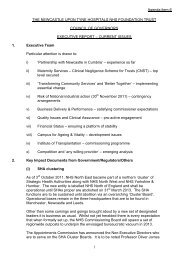
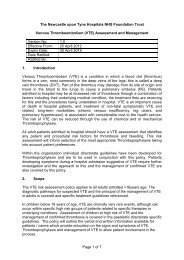
![Standard Precautions Policy - 112KB [PDF] - Newcastle Hospitals](https://img.yumpu.com/51150129/1/184x260/standard-precautions-policy-112kb-pdf-newcastle-hospitals.jpg?quality=85)
![Oxygen Management Policy - 38KB [PDF] - Newcastle Hospitals](https://img.yumpu.com/50798872/1/184x260/oxygen-management-policy-38kb-pdf-newcastle-hospitals.jpg?quality=85)
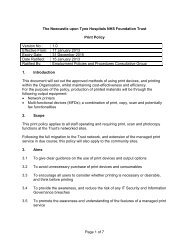
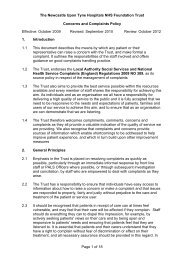
![Patient Identification Policy - 130KB [PDF] - Newcastle Hospitals](https://img.yumpu.com/49156101/1/190x245/patient-identification-policy-130kb-pdf-newcastle-hospitals.jpg?quality=85)
